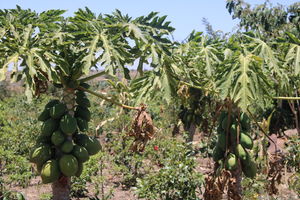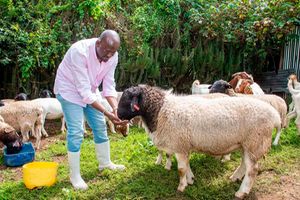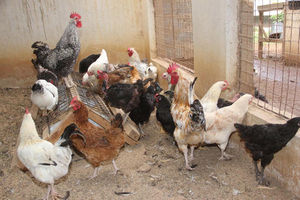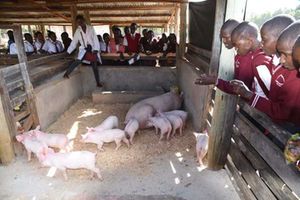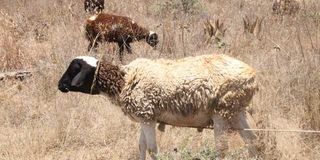
A Black Welsh sheep breeding under fattening in a farm at Thome in Laikipia County in this photo taken of March 6, 2025.
Enticed by the growing demand for mutton and chevon, many families in Nyandarua and Laikipia counties are now engaged in commercial sheep farming.
Farmers involved in the business say it requires extensive research, consultations and understanding of market trends.
Rewards far outweigh the challenges for those who get it right.
Some farmers have abandoned horticulture, despite investing millions of shillings in complex irrigation systems, to concentrate on fattening sheep. Some are selectively breeding high-quality ewes to have premium lamb and mutton.
Faith Wangu, a resident of Rumuruti, knows this shift. A sophisticated drip irrigation system covers her 50 acres, a reminder of Wangu’s earlier venture.
She pumped at least Sh10 million in a borehole, irrigation water tanks and other infrastructure in 2014. By 2018, however, she had suffered repeated losses due to fluctuating market prices, unfavourable weather and high operational costs.
“I even gave up on farming as the losses were unbearable,” she tells Seeds of Gold.
In 2020, she decided to try sheep farming.
Wangu began with 50 sheep. The number grew to 150 in two years. She had been trained on how to ensure her sheep gained weight.
During the festive season in 2022, Wangu sold 100 sheep for Sh20,000 to Sh25,000 per animal.
“That is when I decided to focus fully on commercial sheep farming,” she says, adding that her model revolves around strategic buying.
She buys lambs in Rumuruti when prices are low, especially during dry periods. A five-month lamb weighing around 18 kilos goes for Sh5,000 to Sh8,000.
For the April market, Wangu buys the lambs in January and February. Those to be sold in December are bought in October and November.
Wangu specialises in Dorper and Black Welsh crosses, which adapt well to weather in the region.
David Maitai, a farmer in Ndaragua, has taken commercial sheep farming to a new level. He has introduced selective breeding and has a veterinarian to manage the health and nutrition of his flock.
Maitai say the ideal time to start fattening sheep for mutton is at nine months.
“At this stage, one can identify the best sheep for fattening, those to be retained for breeding and animals with stunting signs,” he says.
Maitai says good practices from pregnancy to lambing reduce the chances of stunting. If an ewe is properly cared for, it produces strong, healthy lambs.
The fattening takes two months, during which the animals are given a special diet of supplements. At the end of this period, a sheep weighs 30 to 50 kilos and is ready for the market.
“Correct feeding is key. I have an agreement with the Kenya Forest Service that allows us to graze the sheep in the forest, which has a variety of indigenous pasture that enriches the taste and quality of the mutton,” he says.
To maximise weight gain and meat quality, Maitai gives every sheep a quarter of a kilo of formulated diet containing maize germ, wheat bran, soya, sunflower and cotton oilcake. The animals are also given mineral-rich supplements, including calcium, zinc and vitamin-enriched salts.
“Water must always be available. Free-range grazing is preferred as most pasture contains vitamins, iron, calcium and magnesium. It reduces feeding costs,” he says
Choosing the right breed for commercial fattening is important as different breeds thrive in different climatic conditions. Understanding market trends is crucial too.
Maitai says the peak selling season is December to April. “If you don’t sell the fattened sheep in this window, you may incur losses,” he says.
The location of his farm in Mairo-Kumi – off the Nyeri-Nyahururu-Nakuru road – is an advantage. The strategic location means Maitai attracts customers from Nyeri, Nyahururu, Nairobi and Nakuru, who would travel 45 kilometres to Rumuruti.
Getting quality sheep at a fair price during peak seasons can be a challenge.
Kaniaru Kariuki, a regular customer, now books his sheep in advance at Maitai’s farm.
“I have already booked four for Christmas 2025. It saves time and resources,” he says.
Kariuki adds that ordering early protects customers from price spikes during the festivities.
“Sheep prices often double in December. Last year, a sheep that cost Sh8,000 a few months earlier sold for Sh15,000 to Sh25,000, depending on location,” he says.
Nyandarua County Assistant Director for Livestock Development John Gichuki advises farmers to invest in proper housing for breeding and fattening.
“A well-planned farm should have separate pens for the general flock, maternity, lambs and fattening rams,” he says.
Gichuki adds that young rams should be separated from ewes as inbreeding affects genetic quality, while overworked rams produce weak offspring, resulting in stunted growth.
Ewes should be moved to a maternity pen and vaccinated against diseases two months before giving birth. Their diet should be adjusted to include concentrated feed, hay and vitamin supplements.
After lambing, protein intake should be increased to improve milk production, with salts used as an additional supplement, Gichuki says.
Overfeeding rams with high-concentrate diets is discouraged as it can lead to digestion complications. The recommended daily intake is 250g per ewe.
“Farmers should select high quality rams and prioritise ewes with strong maternal traits and large bodies to produce high quality lambs for fattening,” Gichuki advises.
